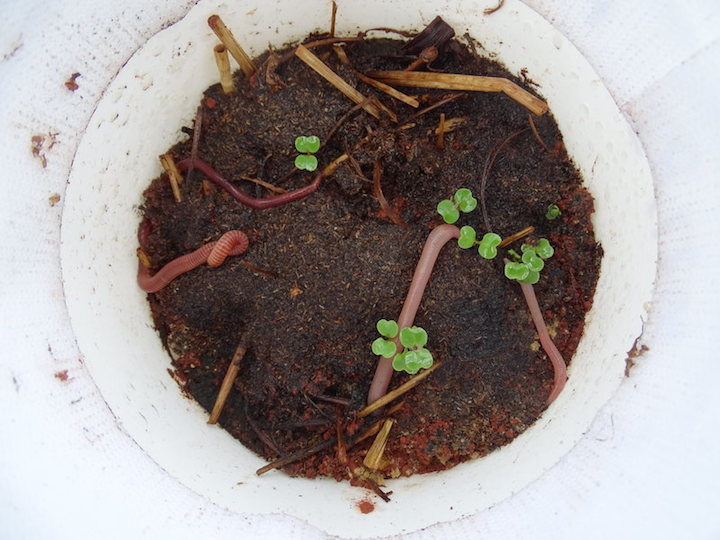1.10.2017
Are Earthworms Tough Enough for Mars?
One ecologist is trying to find out.

IN A RECENT SPEECH IN Adelaide, Australia, the aspiring space maven Elon Musk updated the public on his plans for colonizing Mars. His current vision includes a massive 40-cabin spacecraft, an aspirational launch date of 2024, and technology that can produce fuel from the planet’s thin atmosphere.
As with the heady beginnings of most space travel plans, this is all very glitzy and appealing. If you ask Wieger Wamelink, though, any successful Mars mission will eventually have to leave room in the plans for something a bit more quotidian: a heck of a lot of worms.
Wamelink, a senior ecologist at Wageningen University & Research in the Netherlands, spends most of his time studying Earthly questions. Much of his work involves what he calls “plant-soil relations,” or figuring out why particular plant species will grow easily in one place, and not at all in another. A few years ago, though, he became interested in a far-flung version of this question: if humans were able to provide them with water, air, and climate control, could some plant species grow on dirt from the moon? What about from Mars?

At first, Wamelink proposed a theoretical study, based on comparing plant needs with what we know about these extraterrestrial soil types. But then he learned that NASA actually sells simulants of each, based on samples analyzed by probes or, in the case of the Moon, brought back by astronauts. “I thought, why not change the project into something experimental?” Wamelink says. So in 2013, he and his students filled a greenhouse with three sets of pots: some with lunar dirt, some with Martian dirt, and some with dirt from the Rhine river. (Wamelink deliberately chose a coarse, nutrient-poor Earthly soil, he says, to even the playing field a bit.)
They planted 4,200 seeds from various useful plant species, including nitrogen-fixers such as lupin and clover, and four different crops: rye, carrots, tomatoes, and garden cress.
“Our expectations were low,” says Wamelink. But just a few days after planting, sprouts started popping up. In the end, “almost all the seeds germinated,” he says. Although the simulated moon plants withered quickly after sprouting, the others thrived, producing flowers, fruits, and even seeds. “The Mars soil simulant was even better than the Earth control that we used,” he says. “That was maybe the biggest surprise.” (He and his team later published this research in PLOSOne.)

The next year, 2014, Wamelink and his students mixed things up. They grew only crops—ten species, including radishes, chives, and arugula—and they enriched the soils with dead plant parts, to mimic what might happen in a successful space-gardening scenario. They switched the Earth control to potting soil, now that the space soils had proved they could pull their weight. This imrpoved things: On the Mars soil, “all the plants did well except the spinach,” he says. “Even on the moon soil we had tomatoes, though they never made it to red.”
They tested the vegetables for heavy metals—a concern with space dirt, which contains cadmium, copper, and lead—and also came up clear: “the lead content was higher in the tomato we grew on Earth potting soil,” Wamelink says. After the third experiment, which was completed last year and aimed at getting as large a harvest as possible, they served up the fruits of their labor, complete with an interplanetary tomato taste test. (“The Mars soil tomatoes were a bit more sweet,” says Wamelink.)
These results have been promising. But soil alone can only do so much: a sustainable off-earth farming ecosystem also involves fungi, bacteria, and pollinators such as bees and butterflies. (Wamelink is betting on bumblebees: “you can keep them in hibernation,” he says, so they’d easily survive the rocket trip.) Over the past month, he and his team have begun testing the next most important ecosystem member—earthworms—to see if they are able to hack it in relatively harsh exoplanetary dirt.

The dangers are many: lunar dirt is very sharp, because the moon lacks weather. “Stones and rocks over there fall apart because of cosmic radiation,” says Wamelink. “But they just fall apart and lie there. They have all kinds of sharp edges… imagine eating glass.” (Martian dirt has the same problem, though to a lesser extent.) The heavy metals, too, pose a threat: at certain concentrations, copper and cadmium are toxic to at least one common worm species.
If the earthworms do prove flexible about their earthiness, though, they’ll be a great help. On this planet, they are incredible gardening accomplices, breaking down organic matter into forms that plants can soak up, and aerating the soil with their burrows so that nutrients and water can reach their roots.
In space, they’ll be even more vital: “Moon soil especially is very compact and dense,” says Wamelink. “Even air has trouble getting in.” He thinks this may be one reason that the lunar soil tends to underperform. By tunneling, worms could provide the necessary egress, solving this problem.

The official worm experiment started last week: Wamelink made worm homes out of organic matter, pig slurry, and the various soils, planted some arugula seeds, and dropped in several different types of wrigglers. Now, the waiting and watching begins. (You can follow the experiment’s progress on the group’s Facebook page.) But Wamelink, in his excitement, has given himself a sort of sneak peek: since February, he’s had worms in Martian-style soil living in a small terrarium on his desk.
“They are still alive,” he says. “They really seem to like it. They seem to be very happy.” One small bite for worm, one giant dig for wormkind.
Quelle: Atlas Obscura
